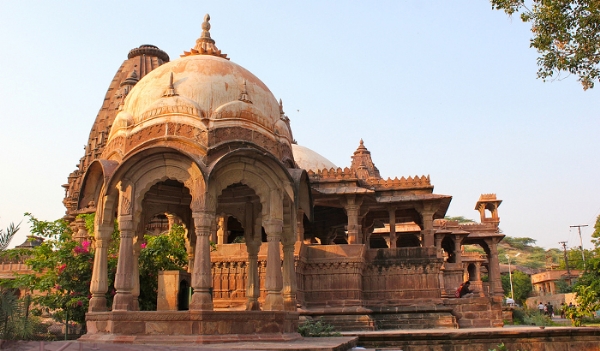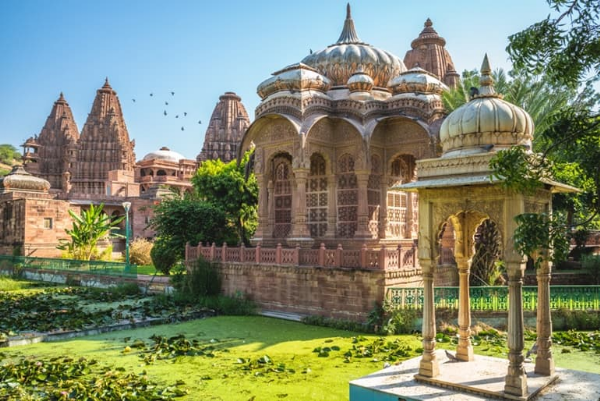Mandore Gardens: the abandoned beauty of Jodhpur
A unique Hindu temple, which is referred to as the temple of 33 crore gods, is a spot you shouldn’t miss in the garden
Total Views |
Those who love architecture are in a for a treat today, as the place we will explore today is one that is not just lesser known, but also has the detailing which is sure to stun you. It is definitely a place less explored and deserves to be acknowledged more, for the beauty it holds. Even today, the Mandore Gardens have the presence to tell the story of the ancient era. The site is definitely very well-preserved. Abandoned since 1459 CE, the ancient town of Mandore is 9 kms north of the tourist-heavy Jodhpur in Rajasthan.


The lush green gardens surrounding these buildings only add to the irresistible charm of this place. These cenotaphs remind of the ancient eras, and the architectural brilliance people had at that time. There are sign boards in the garden, showcasing the name of the Jodhpur rulers for whom these stunning structures were built for.

History | In 6th-century CE, the town of Mandore used to be the prominent seat of the authority of the Pratiharas of Mandavyapura. The princess of the Pratiharas, married King Rao Chunda of the Rathore dynasty, who received Mandore’s Junagarh Fort as a dowry in the wedding. In 1427, Mandore became the seat of the Rathore clan, and Rao Rinmal Rathore became the ruler of Mandore. Moreover, Rinmal too was the administrator of the Kingdom of Mewar until 1438, when he was assassinated by the Mewar ruler Rana Kumbha. He then took over the throne of Mandore. Rao Jodha, (son of Rinmal) managed to escape the assassination and tried recapturing Mandore for many years, but all of his attempts failed. Finally, in 1453, Rao Jodha managed to get Mandore back.
Over the centuries, Mandore was the capital of several different Jodhpur kings. It has also witnessed several invasions from different dynasties, including the Muslim kings of Gujarat and Malwa. Hence, in order to protect Mandore from more invasions, the capital was shifted to the hilltop Mehrangarh Fort, as it offered more protection to the royal kingdom.
This ancient town was left in ruins following the abandonment. Today, all that’s left is the Mandore Gardens that have survived through all this history. It is a piece of history that reminds tourists of the town’s glorious past. The Mandore Gardens houses ancient temples, memorials and high-rock terraces. Visitors can spend the whole day soaking in the beauty of this place.
Guess the mesmerising location ? pic.twitter.com/1QesRmlrRR
— Desi Thug (@desi_thug1) February 2, 2022
Features | The structures inside the garden are undoubtedly one of the most striking features here. As an example, the Hall of Heroes has 16 figures of warriors carved from a single rock! The Hall of Heroes is definitely a stop that everyone should make if they are interested in folk heroes and their history. Splendid images and statues of the Rajput heroes detail the walls of the hall. The unique Hindu temple, which is referred to as the temple of 33 crore gods, too, is a spot you shouldn’t miss in the garden. This temple hosts beautiful images of Hindu deities, that depict the skilful artistry during that period.

Another one of the intriguing features in the garden are the Cenotaphs or dewals of the various Maharajas of Jodhpur, which is sure to leave you stunned, as they have been kept in such a well-preserved state. The cenotaphs date back to the 17th-18th centuries. The most beautiful and well-known of these dewals is the one belonging to Maharaja Ajit Singh. The cenotaphs are basically a group of red sandstone buildings with intricate carvings, pillars, tall spires, elaborate corridors and sculptural embellishments.
The lush green gardens surrounding these buildings only add to the irresistible charm of this place. These cenotaphs remind of the ancient eras, and the architectural brilliance people had at that time. There are sign boards in the garden, showcasing the name of the Jodhpur rulers for whom these stunning structures were built for.
Also Read | Hoysala temples: An umbrella of 100 creations by the Hoysala empire
The government museum present here is also a highlight of the garden. It houses artefacts, relics that have great historical importance to the region. There is also a Mandore Palace and Fort on a hilltop which have origins dating back to the 6th-century. It lies in ruins today, but still is worth a visit.


